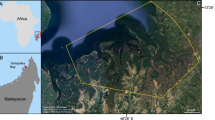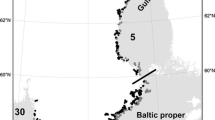Abstract
Turf-forming algae form more extensive habitat on subtidal rock adjacent to urban than non-urban coast of South Australia. This pattern is frequently observed on the world’s temperate coasts and is variously considered to be a result of enhanced concentration of nutrients or rates of sediment deposition on urban coasts. We experimentally tested which of three components of environmental change (increased nutrients in water, increased nutrients in sediments and increased sediment deposition) best explain the expansive covers of turf-forming algae on urban coasts. All three treatments had independent and positive effects on the percentage cover of turf-forming algae. The addition of nutrients from the water column had the largest influence (ω 2=0.55), which was more than six times greater than the effect of nutrients added to sediments (ω 2=0.08). An increase in rate of deposition of sediments had substantial effects (ω 2=0.35), which were about one third less than those of water-borne nutrients. Importantly, the combined effect of all three treatments caused a 77% increase in percentage cover of turf-forming algae, which is comparable to the observed difference in covers between urban and non-urban coast in South Australia (93%). These results suggest that human activities that reduce water quality in both nutrient and sediment loads account for major change observed on human-dominated coasts. Despite this knowledge, we still lack complete information on the mechanisms that switch the primary subtidal habitat from canopy-forming algae to turf-forming algae on human-dominated coasts.




Similar content being viewed by others
References
Airoldi L (1998) Roles of disturbance, sediment stress, and substratum retention on spatial dominance in algal turf. Ecology 79:2759–2770
Airoldi L (2003) The effects of sedimentation on rocky coast assemblages. Oceanogr Mar Biol Annu Rev 41:161–236
Airoldi L, Virgilio M (1998) Responses of turf-forming algae to spatial variations in the deposition of sediments. Mar Ecol Prog Ser 165:271–282
Airoldi L, Rindi F, Cinelli F (1995) Structure, seasonal dynamics and reproductive phenology of a filamentous turf assemblage on a sediment influenced, rocky subtidal shore. Bot Mar 38:227–237
Benedetti-Cecchi L, Pannacciulli F, Bulleri F, Moschella PS, Airoldi L, Relini G, Cinelli F (2001) Predicting the consequences of anthropogenic disturbance: large scale effects of loss of canopy algae on rocky shores. Mar Ecol Prog Ser 214:137–150
Boynton WR, Kemp WM, Osborne CG (1998) Nutrient fluxes across the sediment-water interface in the turbid zone of a coastal plain estuary. In: Kennedy VS (ed) Estuarine perspectives. Academic, London
Carpenter SR, Caraco NF, Correll DL, Howarth RW, Sharpley AN, Smith VH (1998) Nonpoint pollution of surface waters with phosphorus and nitrogen. Ecol Appl 8:559–568
Cheshire A, Miller DJ, Stewart R (1999) Effect of dispersed sediment plumes from beach and sand replenishment dredging on recruitment of phaeophycean algae to rocky reefs in Gulf St. Vincent, South Australia. A report to the Environmental Protection Authority of South Australia. Department of Environmental Biology, University of Adelaide
Connell SD (2003) The monopolization of understory habitat by subtidal encrusting coralline algae: a test of the combined effects of canopy-mediated light and sedimentation. Mar Biol 142:1065–1071
Dayton PK (1985) Ecology of kelp communities. Annu Rev Ecol Sys 16:215–245
Eriksson BK, Johansson G, Snoeijs P (2002) Long-term changes in the macroalgal vegetation of the inner Gullmar Fjord, Swedish Skagerrak coast. J Phycol 38:284–296
Goodsell PJ, Connell SD (2002) Can habitat loss be treated independently of habitat configuration? Implications for rare and common taxa in fragmented landscapes. Mar Ecol Prog Ser 239:37–44
Goodsell PJ, Fowler-Walker MJ, Gillanders BM, Connell SD (2004) Variations in the spatial configuration of algae in subtidal forests: implications for invertebrate assemblages. Aust J Ecol (in press)
Graham MH, Edwards MS (2001) Statistical significance versus fit: estimating the importance of individual factors in ecological analysis of variance. Oikos 93:505–513
Greig TJ (2000) Investigating the effects of substrate texture on the recruitment of sessile marine organisms: an experimental approach. Honours thesis, Department of Environmental Biology, The University of Adelaide
Häkanson L, Floderus S, Wallin M (1989) Sediment trap assemblages—a methodological description. Hydrobiologica 176/177:481–490
Hillebrand H (2003) Opposing effects of grazing and nutrients on diversity. Oikos 100:592–600
Hulme M, Barrow EM, Arnell NW, Harrison PA, Johns TC, Downing TE (1999) Relative impacts of human-induced climate change and natural climate variability. Nature 397:688–691
Irving AD, Connell SD (2002) Interactive effects of sedimentation and microtopography on the abundance of subtidal turf-forming algae. Phycologia 41:517–522
Irving AD, Connell SD, Gillanders BM (2004) Local complexity in patterns of canopy-benthos associations produces regional patterns across temperate Australasia. Mar Biol 144:361–368
Kendrick GA (1991) Recruitment of coralline crusts and filamentous turf algae in the Galapagos archipelago: effect of simulated scour, erosion and accretion. J Exp Mar Biol Ecol 147:47–63
Kennelly SJ (1987) Inhibition of kelp recruitment by turfing algae and consequences for an Australian kelp community. J Exp Mar Biol Ecol 112:49–60
Meese RJ, Tomich PA (1992) Dots on the rocks: a comparison of percent cover estimation methods. J Exp Mar Biol Ecol 165:59–73
Melville AJ, Connell SD (2001) Experimental effects of kelp canopies on subtidal coralline algae. Aust J Ecol 26:102–108
Norderhaug KM, Christie H, Rinde E (2002) Colonisation of kelp imitations by epiphyte and holdfast fauna; a study of mobility patterns. Mar Biol 141:965–973
Pfister CA, Van Alystyne KL (2003) An experimental assessment of the effects of nutrient enhancement on the intertidal kelp Hedophyllum sessile (Laminariales, Phaeophyceae). J Phycol 39:285–290
Smith SDA, Simpson RD, Cairns SC (1996) The macrofaunal community of Ecklonia radiata holdfasts: description of the faunal assemblage and variation associated with differences in holdfast volume. Aust J Ecol 21:81–95
Stewart JG (1982) Anchor species and epiphytes in intertidal algal turf. Pac Sci 36:45–59
Stewart JG (1983) Fluctuations in the quantity of sediments trapped among algal thalli on intertidal rock platforms in Southern California. J Exp Mar Biol Ecol 73:205–211
Tilman D (1999) The ecological consequences of changes in biodiversity: a search for general principles. Ecology 80:1455–1474
Tilman D, Lehman C (2001) Human-caused environmental change: impacts on plant diversity and evolution. Proc Natl Acad Sci USA 98:5433–5440
Underwood AJ (1997) Experiments in ecology: their logical design and interpretation using analysis of variance. Cambridge University Press
Underwood AJ, Kingsford MJ, Andrew NL (1991) Patterns in shallow subtidal marine assemblages along the coast of New South Wales. Aust J Ecol 16:231–249
Vaughan GM, Corballis MC (1969) Beyond tests of significance: estimating strength of effects in selected ANOVA designs. Psychol Bull 72:204–213
Vitousek PM (1994) Beyond global warming: ecology and global change. Ecology 75:1861–1876
Vitousek PM, Aber JD, Howarth RW, Likens GE, Matson PA, Schindler DW, Schlesinger WH, Tilman DG (1997) Human alteration of the global nitrogen cycle: sources and consequences. Ecol Appl 7:737–750
Western D (2001) Human-modified ecosystems and future evolution. Proc Natl Acad Sci USA 98:5458–5465
Worm B, Lotze HK, Bostrom C, Engkvist R, Labanauskas V, Sommer U (1999) Marine diversity shift linked to interactions among grazers, nutrients and propagule banks. Mar Ecol Prog Ser 185:309–314
Worm B, Lotze HK, Sommer U (2000a) Coastal food web structure, carbon storage, and nitrogen retention regulated by consumer pressure and nutrient loading. Limnol Oceanogr 45:339–349
Worm B, Reusch TBH, Lotze HK (2000b) In situ nutrient enrichment: methods for marine benthic ecology. Int Rev Hydrobiol 85:359–375
Worm B, Lotze HK, Sommer U (2001) Algal propagule banks modify competition, consumer and resource control on Baltic rocky shores. Oecologia 128:281–293
Acknowledgements
We thank Prof. Bryan Womersley for assistance with identification of algae, and Meegan Fowler-Walker, Bayden Russell and Andrew Irving for assistance with fieldwork. We also thank the two anonymous reviewers who provided insightful and helpful additions to this manuscript. David Duncan and Sam Gaylard (Environmental Protection Authority of South Australia) provided historical data on nutrient concentrations. A grant to Sean Connell from the Australian Research Council supported this research.
Author information
Authors and Affiliations
Corresponding author
Additional information
Communicated by M.S. Johnson, Crawley
Rights and permissions
About this article
Cite this article
Gorgula, S.K., Connell, S.D. Expansive covers of turf-forming algae on human-dominated coast: the relative effects of increasing nutrient and sediment loads. Marine Biology 145, 613–619 (2004). https://doi.org/10.1007/s00227-004-1335-5
Received:
Accepted:
Published:
Issue Date:
DOI: https://doi.org/10.1007/s00227-004-1335-5




